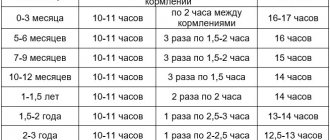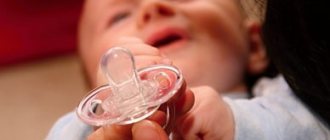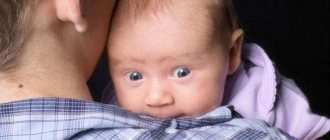What to do if a child rolls up while crying?
When a newborn cries, he is showing his dissatisfaction, fear, or other emotions.
It’s another matter when a child rolls up while crying, thereby greatly frightening his parents. In medical terminology, this condition is called affective-respiratory paroxysm (ARP). The baby holds his breath when exiting, after which he cannot inhale normally for some time. Parents must learn to distinguish a regular tantrum from an ARP. In the first case, the baby protests for a long time, cries and screams loudly. But during an attack of ARP, he becomes inactive, his skin turns blue, and the baby even loses consciousness.
Currently, there are two main types of ARP:
- Pale attacks. Usually this phenomenon occurs as a result of severe pain or fear. For example, a pale attack may appear after an injection. In this case, the pulse completely disappears for some time and the heartbeat is delayed. The child loses consciousness. In the future, such children often experience fainting.
- Blue attacks. Appear as a result of the baby’s anger or dissatisfaction. The child begins to scream, but when he inhales, his breathing stops, after which he becomes silent and turns blue.
As a rule, both attacks occur quickly and pass within 30 seconds. But sometimes they are protracted. The baby may become soft or, on the contrary, muscle spasms appear, causing the child to arch in the shape of an arc.
Sooner or later, almost every mother has a question: “Why does the child roll up when crying?” This phenomenon usually appears in the first years of life, and completely disappears by about eight years.
Some parents mistakenly believe that the baby is faking a seizure, thereby wanting to control the adults.
However, ARP has a reflex nature, which is why the baby breaks down into a crying fit, and in some cases even loses consciousness.
Breathing stops for half a minute or even a minute. As a result, the color of the skin changes and the child turns blue. Most often, ARP appears in irritable, aggressive and overly active children.
In addition, the following reasons provoke an attack:
- Frequent stressful situations, attacks of anger. Moreover, even ordinary discomfort - fatigue or lack of food - can stimulate ARP.
- Often the reason why a child rolls up while crying is the parents. You cannot overprotect your baby and give him everything he wants. After all, if you then deny him something, he will react violently, which will cause another attack.
In any case, you need to consult a doctor after the first attack of ARP while crying. The neurologist will conduct a diagnosis, after which he will prescribe treatment. You should not delay visiting a specialist, as over time the attacks may become epileptic.
If attacks of ARP are frequent and long-lasting, the child will:
- rolls up while crying and loses consciousness;
- convulsions begin;
- he becomes pale;
- lips turn blue.
As a result of the spasms, the baby's muscles become very tense, causing his small torso to arch.
In more rare cases, cramps are accompanied by involuntary urination. As a rule, breathing is restored immediately after the cramps pass.
What to do when a child rolls up while crying?
- The main thing is not to panic. It is urgent to restore the baby's breathing. To do this, just pat him on the cheeks, sprinkle him with cold water, and direct a stream of fresh air into his face. Under no circumstances should you shake your child or hit him in the face too hard.
- At the age of 5 years, children's bones are still very fragile, so intense exposure to them can lead to fractures and dislocations. If the attacks are not severe, then tickling helps restore breathing.
- Sometimes symptoms of ARP resemble epilepsy. In this case, the attacks last a long time - more than one minute, and convulsions appear. In this case, the baby must be placed on its side to avoid suffocation. Sometimes it is necessary to hold the legs and arms so that the baby does not injure himself.
First aid measures should be started immediately after the symptoms of an attack appear. After the child’s breathing is restored, the baby needs to be distracted by offering him a bright toy. To calm the baby, you need to put him to the chest and hug him.
If a child rolls up while crying, it is necessary to urgently begin treatment:
- Parents turn to a neurologist, who, before conducting diagnostic tests, asks the parents a number of questions: why the attack occurred, how it went, what preceded it. In addition, the doctor clarifies what symptoms accompanied the attack (blueness, urination, chest pain, rapid heartbeat).
- After this, the doctor prescribes an examination. An ECG, ultrasound and EEG of the brain are performed, urine and blood tests are taken. Only after this the neurologist prescribes treatment. As a rule, children with attacks of ARP should be under medical care until they are 5-7 years old.
- Treatment includes two directions - medicinal and non-medicinal. If the child is over 3 years old, the doctor recommends making an appointment with a psychologist. In addition, the psychologist will adjust the methods of raising the child so that the atmosphere in the family is calm and friendly. The specialist offers parents a number of games and exercises that help suppress outbursts of anger.
- During play activities, the child forgets about all his problems, he becomes calmer. Non-drug treatment is leading. And if you arrange the environment correctly, your baby may not even need to take medications.
- In more complex cases, the doctor prescribes medications to treat neuropathy and increased excitability of the child. All medications are prescribed exclusively by a neurologist. You should not buy tablets on the advice of friends or pharmacists.
If a child rolled while crying and turned blue once, this phenomenon may repeat.
To prevent this from happening, you must adhere to certain measures:
- Parents must teach their children to control their emotions. In addition, adults should avoid situations that can cause a violent response from the baby’s body. It is not recommended to expose children to long trips or walks, during which they become overtired.
- Some kids don't like to rush. They are slowly getting dressed for kindergarten. You should not push them, as this may provoke anger. It’s better to wake up your baby 5 minutes earlier so that you can get ready without rushing. If an attack has already begun, you should not shout at the child, as this will frighten him even more. It is necessary to approach this issue tactfully and reassure the baby. If the child is an adult, after an attack he needs to be explained that he must breathe correctly and remain calm in any situation.
- It is important that both parents participate in the upbringing process.
- If seizures occur in a “home” child, it is recommended to enroll him in kindergarten. Sometimes the opposite happens: the child fails because he does not want to go to preschool. In this case, it is better to leave him at home for a while, and you can take him back to kindergarten only after preparation.
The materials posted on this page are informational in nature and intended for educational purposes. Site visitors should not use them as medical advice. Determining the diagnosis and choosing a treatment method remains the exclusive prerogative of your attending physician.
Source: https://allergology.ru/zdorove/rebenok-zakatyvaetsya-pri-plache
The child turns blue
M
Many parents are tormented by watching how violently their newborn baby displays strong positive or negative emotions. From a behavioral point of view, this is normal, because a newborn does not yet know how to adequately express his internal experiences, so they show emotions through crying.
However, often this behavior is accompanied by unpleasant somatic manifestations. While crying, the child practically stops breathing, rolls up and turns blue, falling into a semi-fainting state. Doctors called this phenomenon affective-respiratory paroxysm.
This pathology is typical for children under the age of one year, and, as a rule, completely disappears by the age of three. The cause of paroxysm in a child is nervous overexcitation, so any stress factors can provoke it: anger, fear, excessive fatigue or hunger.
During an attack, the baby loses control over his condition, so during the normalization of the respiratory process, the newborn’s body can be either overly relaxed or overstrained.
Advice
You can help your baby restore his breathing by lightly patting him on the cheeks, blowing on his face, fanning him with newspaper, and massaging his neck and ears.
If a baby turns blue when he cries? Risks causing loss of consciousness
N
Some parents stubbornly insist that children are trying to manipulate them with the help of such nervous crying. However, attacks of affective-respiratory paroxysm cannot be caused artificially, because they represent a reflex response of the newborn body to stress.
When a baby cries, oxygen is completely released from his lungs.
All this is accompanied by the following symptoms:
- Spasm of laryngeal muscles
- The child can't make a sound
- Skin turns blue
- Tonic cramps occur or muscle tone weakens
- Loss of consciousness
Typically, the oxygen supply stops for 15-60 seconds.
During this time, the baby may lose consciousness
, which is the body’s protective reaction to the lack of oxygen in the lungs. A minute later, in order to save the body saturated with carbon dioxide, the brain center gives a signal to relax the muscles of the larynx. When the child begins to breathe, he finally comes to his senses.
Advice
Doctors advise spraying water on the child or wiping him with a damp and cool towel to quickly bring him to his senses. You can distract the child's attention from the oncoming attack by lightly tickling him or showing him a bright toy. It is the lack of oxygen that is the main cause of cyanosis - the blueness of the baby's skin. This happens because in an oxygen-free environment, the level of hemoglobin in the blood increases, and the blood turns from bright red to dark.
The child’s cheeks have turned blue, affective-respiratory attacks are possible
I
The phenomenon in which a child's cheeks turn blue is quite common. The mechanism of this reaction of the body is simple: the level of reduced hemoglobin in the blood increases, which makes it darker. Cyanosis manifests itself against the background of a general oxygen deficiency. There is very thin skin on the child’s cheeks and the blood vessels are located very close to it, so, first of all, they turn blue.
Factors that have a detrimental effect on fragile blood vessels can cause blue skin on a baby’s cheeks:
- Hypothermia (Frostbite);
- Cardiovascular diseases (for example, anemia);
- Respiratory tract diseases.
However, most often, cyanosis of the skin appears in conjunction with affective-respiratory attacks
.
Attention!
If your child begins to turn blue not only his cheeks, but also his lips, the skin of his palms and feet, contact an ambulance immediately!
To return the baby’s cheeks to their normal rosy color, you need to eliminate the cause of this phenomenon. Help your newborn catch his breath after a seizure by blowing on him and gently massaging his chest and back between the shoulder blades.
What causes a child to roll when he cries? Solving the problem
ABOUT
One of the signs of an affective-respiratory attack is muscle spasms, in which the child rolls up and becomes unable to move his limbs. A typical picture for paroxysm: a newborn has a slightly open mouth, an immobilized body, arched.
When a child cries, his eyes may roll back and his consciousness may turn off. If the child rolls while crying, do not show your panic, act calmly and confidently.
The calmer the parent is, the faster the baby will calm down. Adhere to the following rules:
- Don't hesitate. It is easiest to stop an attack at the beginning.
- Attract the child's attention, and to provoke a reflex breath, try to make him laugh.
- If your baby begins to have tonic convulsions, place him on a flat surface with his head turned to the side. This way, if an attack of vomiting occurs, he will not choke.
- When the baby comes to his senses, reassure and reassure him, because he most likely does not understand what happened to him.
Do not leave affective-respiratory seizures unattended, because there is a possibility that in the future they can develop into epileptic seizures.
And prolonged and frequent hypoxia, which occurs when the baby rolls up, can cause the development of neurological complications.
Conclusion
Z
The future health of a newborn largely depends on the parents. Affective-respiratory attacks need to be taken seriously, because they can also hide serious pathologies. Treatment of this paroxysm should take place in two directions: Adjusting the child’s upbringing and strengthening the nervous system. In any case, consultation with a doctor is necessary.
Source: https://vrebenka.ru/problemy/32-sineet-rebenok.html
Two types of ARP attack
There are two states of a child who collapses while crying. If the baby experiences severe pain, from which he begins to cry, then usually during a short breath-hold he becomes very pale. A sharp slowdown in heart rate is observed during this period. Sometimes it can become thread-like or disappear completely for a short time.
If a child turns blue when crying, then such an attack usually occurs due to emotional affect. During it, you can notice a pronounced cyanosis of the child’s skin, loss of consciousness, and holding his breath. During a prolonged attack, a crying boy or girl seems to go limp, and sometimes, on the contrary, begins to arch.
The child rolls up while crying and loses consciousness (turns blue)
How often does the average baby or toddler cry? There are no exact statistics, but experienced parents know that children can start crying up to 20 or even 30 times a day.
Normal crying is a normal reaction of a child to any irritation: hunger, fear, boredom or the inability to immediately get what he wants.
But what to do if a child rolls up while crying? Loss of consciousness, pallor or bluish skin can greatly frighten others, but, according to pediatricians, this condition is not always a pathology and does not require treatment.
Affective-respiratory attacks
Children often cry for a variety of reasons, usually the child calms down on his own or with the help of others after a few minutes, but sometimes children begin to cry, they become hysterical, cannot calm down on their own and may lose consciousness during such an attack.
Such paroxysms are called affective-respiratory attacks. They occur by holding your breath against the background of crying. When inhaling, breathing stops, air stops flowing into the respiratory organs, due to lack of oxygen, the child may lose consciousness, his skin turns pale or blue. Sometimes hypoxia provokes the development of seizures, weakness and apathy after attacks.
Symptoms
It is quite easy to determine that this is an affective respiratory attack - the child rolls up while crying and loses consciousness, his skin becomes pale, his lips turn blue, his eyes may roll back.
This condition occurs after hysterics, prolonged crying or screaming. The attack lasts from a few seconds to 1-3 minutes, after which the child comes to his senses, as if “waking up”. After an attack, the child becomes lethargic, may immediately fall asleep or begin to act up.
Treatment
When a child rolls up and turns blue, parents often panic and don’t know what to do. It is important not to lose control of the situation and know how to provide first aid to a child:
- If the child is conscious, take him in your arms and hold him close.
- If the child has lost consciousness, lay him on his side, turn his head and make sure that his tongue does not stick into his throat. After this, it is better to call an ambulance.
- It is not recommended to try to bring a child out of a seizure using any violent methods - shaking him, splashing him with cold water, screaming, and so on.
RELATED MATERIALS: Main forms of Capgras syndrome: symptoms and treatment
The best remedy if a child rolls up when crying is to prevent the development of attacks. To do this, you need to follow a daily routine and avoid excessive overexcitation, fatigue, and negative emotions.
Prevention of nervous overexcitation will also include sufficient night and daytime sleep, refusal or reduction of sweets in the diet, and proper nutrition.
Daily walks in the fresh air, avoiding watching TV, playing on computers, and so on are helpful.
You can learn more about how to properly respond to such attacks from Dr. Komarovsky, who gives simple and understandable recommendations for parents.
Source: https://opsihoze.ru/psihicheskie-sindromy/pochemu-rebenok-zakatyvaetsya-pri-plache-prichiny-chto-delat-kak-lechit.html
Reasons for crying baby
Newborn babies always cry for a reason. Their tears are evidence that certain circumstances and needs have arisen that make them feel uncomfortable.
In some cases, you can determine what exactly a child needs by looking at his nose. If it is too hot, the baby is overheated. He should take off his clothes that are too warm. When the nose is cold, the baby is cold. He may even start to hiccup due to lack of warmth. You should dress or cover him warmer.
Babies also start crying invitingly when they want to eat. Later, irritated and angry notes appear in their voice.
Children often have bouts of crying before going to bed due to fatigue. You should turn off the lights, eliminate all loud sounds, take the baby in your arms, and rock him a little. He will calm down very soon and start snoring sleepily.
Discomfort is a common reason for crying. So, if a child has itching due to prickly heat, he will cry forcefully. In order not to stress him out again, you need to carefully care for him: change diapers on time, bathe at the optimal temperature that is comfortable for the baby, regulate the temperature in the nursery, do not overheat the baby to avoid diaper rash and rashes.
Babies cry when they are teething, their tummy hurts, and they suffer from migraines. In each of these cases, mother is the best ambulance. It is enough to use the medicine prescribed by the pediatrician, giving it to the child, and there will be no tears.
In some cases, children react sharply to an uncomfortable psychological environment. If conflicts and loud swearing are frequent in the family, they react to this extremely negatively - they begin to cry loudly and hysterically.
It happens that an infant is simply bored. He begins to sob, as if calling on his family to come over, entertain him with a rattle, and pay attention.
Affective-respiratory attacks in children: how dangerous and what to do
Affective-respiratory attacks, this is the scientific name for a condition when a child, during a hysteria or crying, suddenly stops breathing, becomes silent and may even lose consciousness.
This phenomenon is not uncommon in children, and children who are emotional and easily excitable are more likely to get worked up.
The name consists of two words that reflect the essence of the attack - “affective” means the manifestation of violent, uncontrollable, usually negative, emotion.
The word respiratory indicates the source of the problem – the respiratory system. Affective-respiratory paroxysms are not a rare occurrence in children aged 7 months to 3 years.
Due to the child’s underdeveloped respiratory and muscular systems, when he exhales too much, his lungs may be deprived of oxygen, and a spasm of the larynx will not allow him to take a breath in a timely manner. The likelihood of laryngeal spasm increases with a deficiency of calcium and vitamin D in the body, as well as with low hemoglobin in the child’s blood.
What to do with your child in the kitchen: 12 amazing ideas for creativity!
Since the need for calcium in a child is quite high - it is very actively consumed during the construction of bone and dental tissue, to one degree or another, deficiency of this mineral occurs quite often.
Doctors divide attacks according to the color of the skin changes into “pale” and “blue”:
- Pale paroxysm occurs after a child falls, a sudden blow, an injection, or severe fright, while the child may just start crying, but more often breathing stops even before screaming. The child cannot breathe, his mouth is open, but there is no crying. The heartbeat is delayed and the pulse is almost not palpable, the child’s skin turns pale, and in future life children prone to pale ARP are more likely to faint.
- A blue attack is usually a reaction to an emotional storm, dissatisfaction and anger that the child cannot cope with.
Such a reaction can develop when a child refuses to satisfy a momentary desire - to buy a toy, give daddy’s phone number, or a chocolate bar. Starting to cry, the child increases the degree of emotional stress; at one point he cannot breathe in air due to a spasm of the larynx, and the skin acquires a bluish tint. In this state, the child may lose consciousness, a loss of muscle tone is possible - he “goes limp”, or vice versa - he arches from their overexertion.
Source: Burda Media
Despite the fact that the attack looks very scary, pediatric neurologists and pediatricians say that the child’s health, and especially his life, is not in danger. The spasm goes away on its own after a few seconds and the child, as a rule, feels quite normal, if you do not take into account that the reason that provoked the attack remains.
How to help your child
As a rule, the attack goes away within 20-30 seconds on its own - the spasm releases and the child takes a breath.
However, if you don’t have the strength to wait and are very scared, you can try to turn on your breathing by splashing cool water on your face, blowing lightly into your open mouth, or very lightly patting your cheek - this will help you take a reflexive breath.
There is no need to shake the child, hit, or generally make sudden movements; first of all, you need to take a deep breath and pull yourself together.
What to read to children at night: 9 “sleepy” books for kids, published in Ukraine
If a child becomes overwhelmed and begins to lose consciousness, the muscles relax and he may fall. Take your baby in your arms or lay him on his side to prevent falls and injury.
A “blue” attack, which always occurs against a background of hysteria and emotional excitement, can be prevented. If a child is screaming and is already on the verge, try to distract him in any way, knock him off the set program, surprise him - this may be enough to prevent him from stopping breathing.
However, you should not give in at this moment to the demand that caused the hysteria, in this way you can only strengthen the connection in his mind: request-refusal-hysteria-getting what you want.
It is important to remember that a child always responds better to interaction, or otherwise the command “forward”, rather than to a demand to stop any action. If you tell your baby, for example: “Let’s run together, let’s buy ice cream,” he is more likely to switch than if you shout to him “Calm down!!!”
It is necessary to teach a child to cope with attacks of anger and rage; for this, first of all, all family members need to learn how to do this.
What should parents do?
The main thing when rolling is not to panic or get scared. The calmer the parent behaves, the faster the baby calms down.
First of all you need:
- try to calm the child;
- hug and kiss the baby;
- splash water on your face;
- lightly pat him on the cheeks;
- when breathing is restored, switch the child’s attention by starting to tell him a fairy tale or favorite poem.
If your baby suddenly turns blue and loses consciousness, you should:
- lay it on its side;
- hold your tongue to prevent choking and vomiting;
- call an ambulance.
If a child has such attacks, then the parent’s goal is to prevent such situations. In cases where the frequency and nature of attacks worries parents, it is necessary to contact a neurologist. The doctor will conduct a series of tests to determine the cause of such reactions.











